-
TrackoBit
Manage commercial vehicles with the new-age Fleet Management Software
TrackoBit -
TrackoField
Streamline your scattered workforce with Field Force Management Software
TrackoField -
Features Resources
-
Blog
Carefully curated articles to update you on industrial trends. -
White Paper
Insightful papers and analysis on essential subject matters. -
Glossary
Explore an alphabetical list of relevant industry terms. -
What’s New
Get TrackoBit & TrackoField monthly updates here. -
Case Study
Explore the cases we solved with our diverse solutions. -
Infographics
Explore key topics through visually impactful infographics.
-
About Us
Get to know TrackoBit: our team, ethos, values, and vision. -
Careers
Join the most dynamic cult of coders, creatives and changemakers. -
Tech Support
Learn about our technical support team and services in detail. -
Events
Check out the exhibitions where we left our marks and conquered. -
Contact Us
Connect with us and let us know how we can be of service.
Effects of Low Tire Pressure & How to Avoid Them
- Author:Anvesha Pandey
- Read Time:7 min
- Published:
- Last Update: August 4, 2025
Table of Contents
Toggle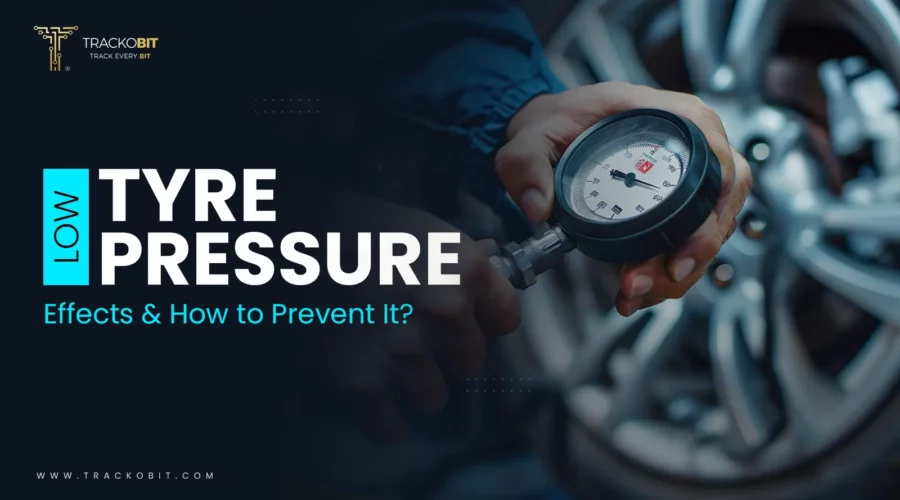
Running a fleet on low tire pressure is risky. Discover the dangers of operating your fleet on low PSI levels and explore top solutions to keep your fleet safe.
Table of Contents
Toggle
Low tire pressure is a common yet often overlooked issue that can have significant repercussions for fleet-centric businesses. Maintaining an optimum tire pressure level can be a challenging task for fleet managers as this decision significantly influences fuel efficiency, vehicle performance, and even vehicle safety.
In fact, various studies showcase that a mere 1 PSI drop in tire pressure can lead to a 0.3% decrease in fuel efficiency. A fleet of 100 vehicles or more translates to a substantial annual fuel cost increase.
Before we start, let’s quickly know what questions should pop into your mind-
- What happens when I drive a vehicle at low tyre pressure?
- For how long can I operate with low tyre pressure?
- What is the optimum PSI air level that I should maintain?
With this let’s unfold the crucial impacts of low tire pressure on day-to-day fleet operations and some really practical tips to prevent and address it.
What is Low Tire Pressure? Basics First
Low tire pressure is when the air pressure inside the tire falls below the manufacturer’s recommended level. Maintaining an optimum tire pressure range is essential for ensuring safe driving, optimal fuel efficiency, and maintaining the tire’s longevity.
When your fleet experiences consistently low tyre pressure increases the risk of blowouts, causes uneven wear and tear, reduces fuel efficiency, and compromises your vehicle’s handling and safety.
Read Blog – What is a Tyre Pressure Monitoring System?
What are the Effects of Low Tyre Pressure?
You may think that having low tyre pressure is not a serious issue. Little did you know, if your fleet is operated on less than recommended PSI, you will risk your fleet, drivers’, and financial health at stake.
a) Decreased Fuel Efficiency
Low tire pressure increases rolling resistance. This means that now the engine has to work harder to move or tread the vehicle. This not only leads to higher fuel consumption but also reduces fuel efficiency, straining your engine and vehicle’s components very badly.
b) Poor Handling and Stability
Underinflated tires can affect the vehicle’s handling. As a result, your fleet driver will find it difficult to steer or manage the vehicle. This, at times, causes your drivers’ to lose control, very dangerous when your fleet is operated over sloppy, wet or slippery roads or surfaces.
c) Increased Tire Wear
Frequent replacement of tires can result in extra expenses on a large scale.
Low tire pressure can cause uneven and accelerated tire wear, particularly on the edges of the tire tread. This reduces the lifespan of the tire. Further resulting in premature tire replacement.
| Do you know?
If you operate your fleet of vehicle at low tire pressure frequently, this can lead to tyres replacements within 1 to 2 years instead of 3-6 years. |
d) Higher Risks of Tire Blowouts
When tires have low air within themselves, they start generating more heat due to increased friction with the road surface. This excessive heat ends up weakening the structure of the tire, resulting in higher chances of blowouts, especially at high speeds.
e) Increased Risk of Hydroplaning
Hydroplaning occurs when the vehicle’s tires lose contact with the surface of the road. Low tire pressure can cause the tire to sit more flat on the road, reducing the tread’s ability to channel water away. This increases the risk of hydroplaning on wet roads, which can lead to loss of control.
Top 5 Ways to Prevent Low Tyre Pressure (Try Them Out)
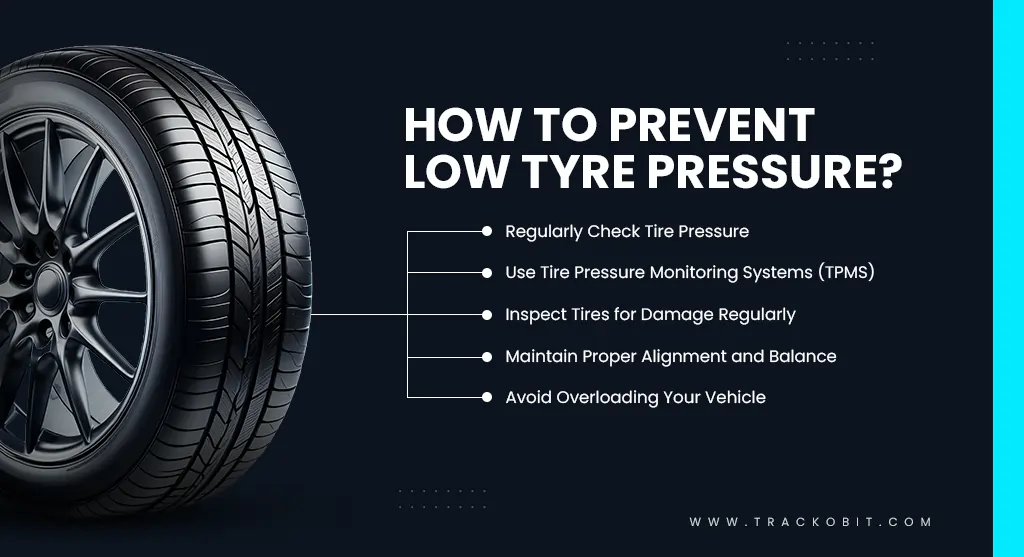
How to Prevent Low Tyre Pressure
1. Regularly Check Tire Pressure
The first step to avoid low tire pressure is to measure it and maintain it from time to time. Avoid PSI levels dropping below 20. Use a tire pressure gauge to check the pressure of all the tires at least once a month. One should always check the tire pressure level more than once during seasonal temperature changes.
Always ensure the tire pressure level according to the manufacturer’s recommended levels this will not only improve safety and fuel efficiency but also will increase tire longevity.
2. Use Tire Pressure Monitoring Systems (TPMS)
Next, invest in a tire pressure monitoring system (TPMS) because it is one of the most effective ways to monitor your tire pressure level continuously. The sensors in the system help you provide real-time information on your tires and notify/ alert you when the air levels drop below the safe level.
TPMS can help you catch low tire pressure early, allowing you to address the issue before it leads to poor fuel economy, uneven tire wear, or even a dangerous blowout.
Investing in a tyre pressure monitoring system provides you with real-time pressure warnings and detailed tyre reports which help in keeping complete supervision of the tire.
3. Inspect Tires for Damage Regularly
Regular tire inspections play a very significant role in preventing low tire pressure which occurs due to leaks or punctures. In such cases, look for signs of wear- these signs can be cracks, bulges, or embedded objects that could cause a slow air leak.
Addressing these minor issues early can prevent more significant problems and avoid unexpected low tire pressure that could compromise your fleet and drivers’ safety on the road.
4. Maintain Proper Alignment and Balance
Proper alignment and balance of your vehicle’s wheels are vital for maintaining consistent tire pressure. When your wheels are misaligned or unbalanced, it can cause uneven tire wear, leading to weak spots that may result in pressure loss over time.
Regular alignment and balancing checks, especially after hitting a pothole or curb, can help ensure that your tires wear evenly and maintain their pressure.
5. Avoid Overloading Your Vehicle
Overloading can also be one of the most significant reasons for low tire pressure. Overloading your delivery vehicle’s heavy goods and consignment can cause excessive strain on your tires, leading to a faster loss of air pressure. Every vehicle has a limit to carrying a maximum load capacity which is often specified by the manufacturer, which you must adhere to.
Carrying loads within its suggested limit not only helps maintain proper tire pressure but also ensures better handling, stability, and the overall performance of the vehicle.
By following the above-mentioned points, you can ensure the tires of your vehicle maintain the correct pressure. These steps will help you improve safety and performance while reducing the risk of tire-related escalations.
| 💡📌 Knowledge Point:-
Low tire pressure light is often represented by a horseshoe-shaped symbol with an exclamation point in the center. This is basically an indicator on your vehicle’s dashboard that alerts you when one or more of your tires have low air pressure. This warning light is part of the Tire Pressure Monitoring System found in most modern vehicles. |
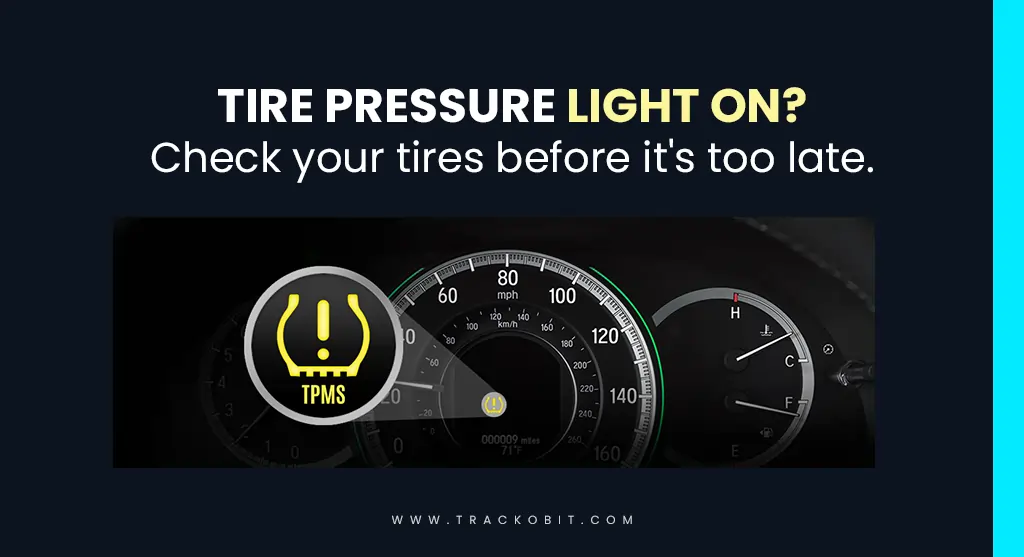
Tire pressure light on
What to Do When Your Low Tire Pressure Light Turns On
It’s always advisable that you don’t ignore low-tire pressure lights. Ignoring this warning can lead to reduced fuel efficiency, decreased handling, and even tire failure.
Here’s what you should do:
- Check Tire Pressure:- First, find the recommended pressure, this is usually listed on a sticker inside the driver’s side door or in the vehicle’s user manual. Use a tire pressure gauge to measure the air pressure.
- Inflate it as per the requirement:- Now that you know the recommended air pressure level, add air to the tires if under-inflated but at the same point avoid overinflation as it can also cause problems.
- Check if there are any leaks:- If you find leaks, look for signs of a puncture, there could be a nail, screw, or other object embedded in the tire.
- Reset the TPMS (Tire Pressure Monitoring System):- This can vary from vehicle to vehicle. To reset the TPMS, you’ll typically need to drive your car for a short distance. This allows the system to recalibrate and detect the correct tire pressure. If the issue persists, turn on/off the ignition.
- Monitor the Tyre Pressure Lights – Now if the light comes on again, check the tire pressure. If the issue still persists, visit a tire service store for a thorough inspection.
⚠️ Always remember driving underinflated tires can be dangerous. Pay attention to your TPMS light and if it’s on, immediately address it.
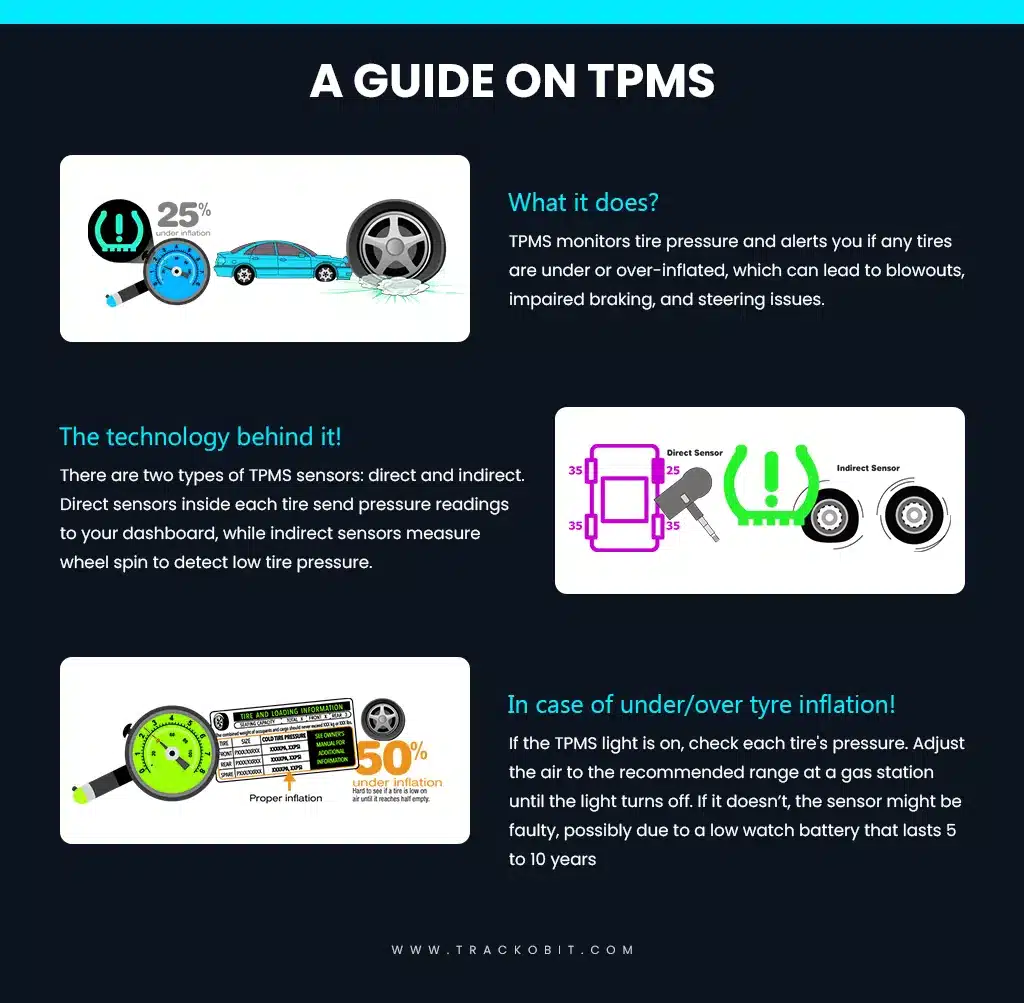
A Guide on TPMS
Don’t Let Low Tire Pressure Put a Dent in Your Wallet- Opt TrackoBit’s TPMS
Here at TrackoBit, we understand the multiple pressure you go through, but we promise low tire pressure won’t be the one. Our vehicle tracking systems outfitted with the best tire health monitoring system not only assure that your vehicles are safe, efficient, and in notch condition but also ensure the tires of your vehicles are moving at the right pressure levels.
Wondering what all you get with TB’s TPMS?
The system integrates with various sensors and offers detailed tire health reports, helping fleet managers prevent issues like fuel wastage and accidents due to under-inflated tires. The system supports both direct and indirect pressure monitoring methods, ensuring accurate data collection and analysis.
This comprehensive approach to tire management improves fleet management, fleet safety, and fuel economy.
Want to know more?
FAQs on Low Tyre Pressure
-
What is considered low tire pressure?
Tire pressure is considered low when it falls below the manufacturer's recommended PSI (pounds per square inch). This recommendation is usually found on a sticker inside the driver’s door or in the owner’s manual. As a general guideline, a drop of 5 PSI or more is often considered low.
-
What are the dangers of driving with low tire pressure?
Driving with low tire pressure can lead to poor fuel efficiency, uneven tire wear, reduced vehicle handling, and increased risk of tire blowouts. It also affects braking distance. This can be dangerous in emergencies.
-
Can I drive short distances with low tire pressure?
Driving short distances with slightly low tire pressure might not cause immediate damage, but it's not recommended. Prolonged driving with low tire pressure can lead to tire damage and an increased risk of accidents.
-
What causes low tire pressure?
Common causes include temperature changes, punctures, leaks in the valve stem, or simply not checking and refilling tires regularly. Cold weather can cause tire pressure to drop, while a slow puncture or a defective valve can also lead to gradual air loss.
-
Does low tire pressure affect fuel efficiency?
Yes, low tire pressure increases rolling resistance, which means your engine has to work harder to move the vehicle, leading to reduced fuel efficiency. Properly inflated tires can improve gas mileage by up to 3%.
Anvesha is a communication specialist at TrackoBit. With a strong background in media and communications, she adds much-needed balance and brevity to TrackoBit’s... Read More
Related Blogs
-

How to Use Driver Behavior Reports as a Sales Hook to Close Big Fleets
Tithi Agarwal October 16, 2025TrackoBit’s driver behavior reports empower fleet providers to win big contracts by showcasing safety, efficiency, and measurable ROI.
-
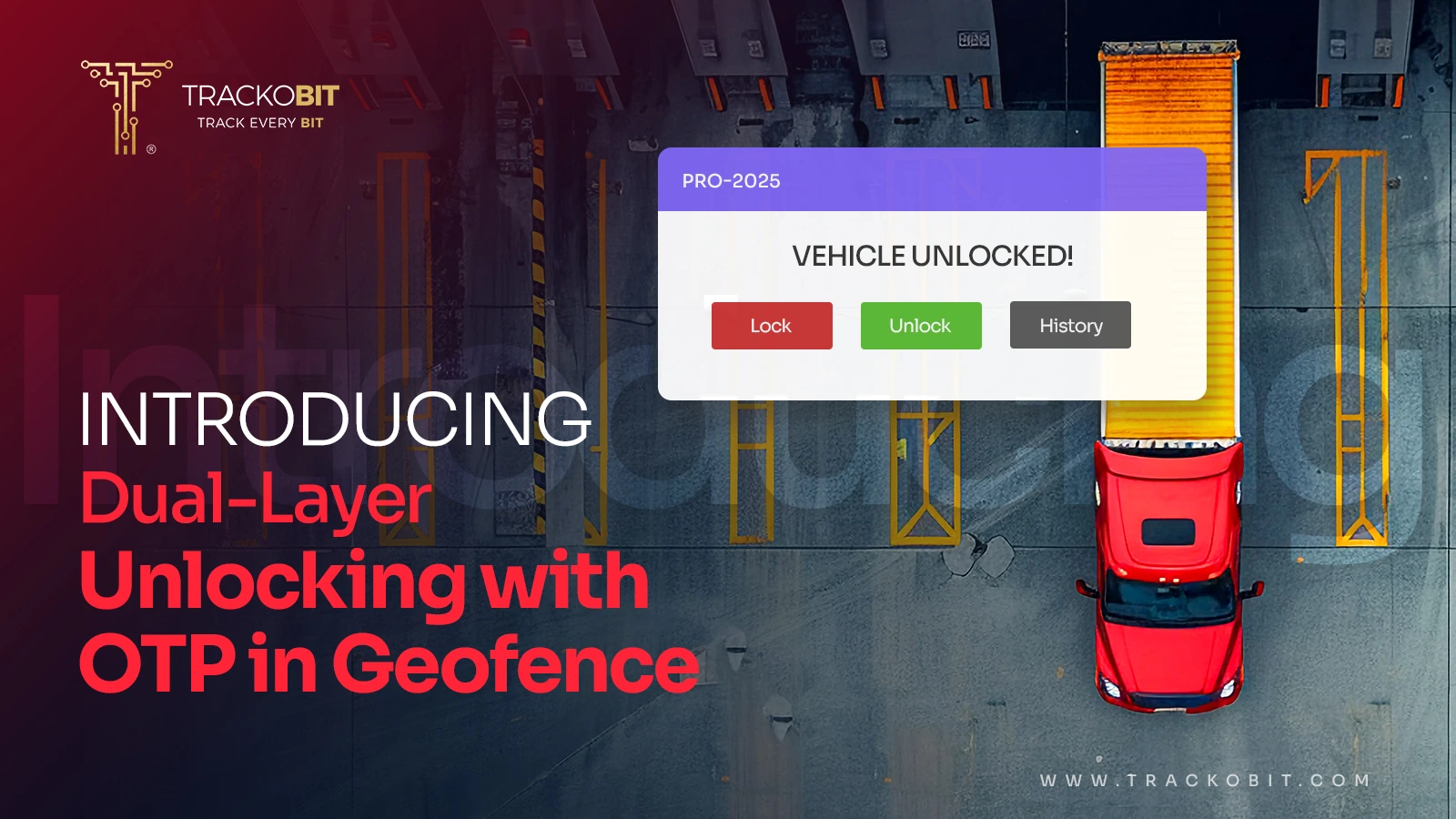
TrackoBit’s Unlocking in Geofence with OTP: Elevating Cargo Protection
Tithi Agarwal September 16, 2025TrackoBit’s latest feature – Unlocking in Geofence with OTP lets you lock out theft and unlock cargo only at the…
-
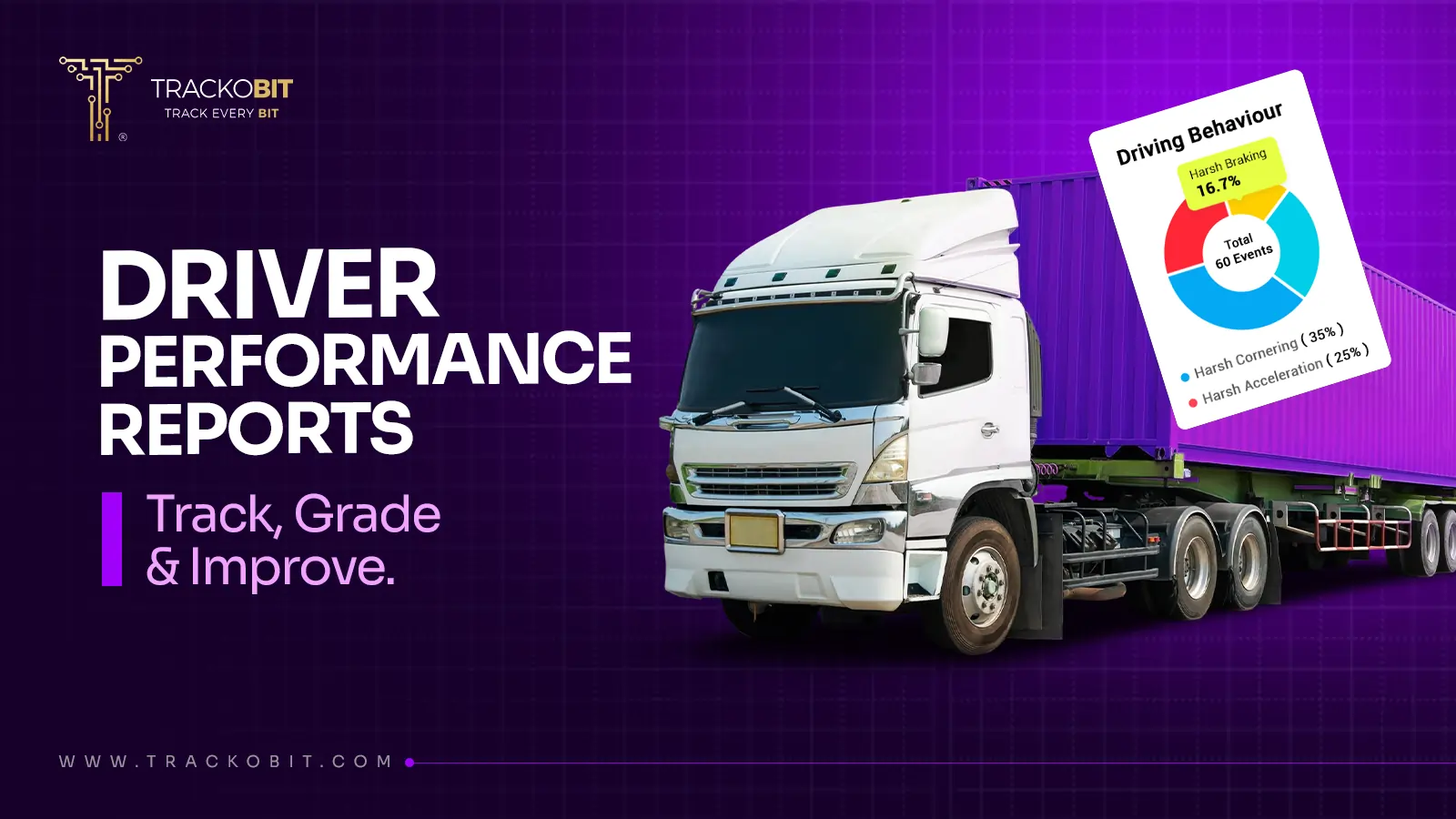
Who’s Really Behind the Wheel? Unlocking Insights with Driver Performance Reports
Tithi Agarwal August 27, 2025Identify top-performing drivers, monitor violations, and grade skills with the driver performance report. This makes fleet operations more transparent and…
-
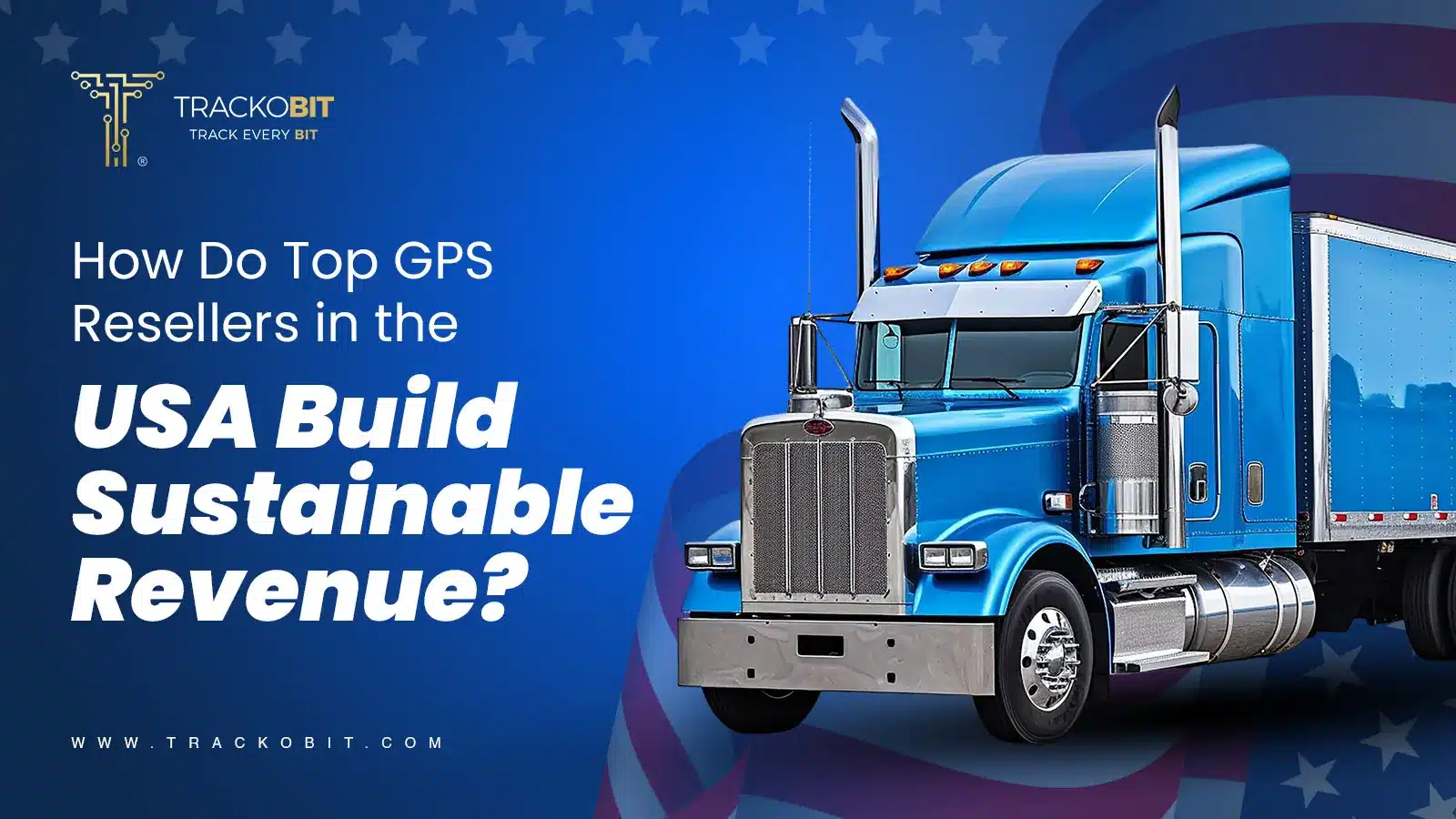
How GPS Resellers in the USA Grow Recurring Revenue with White-Label Fleet Software?
Anvesha Pandey July 3, 2025Are you a GPS reseller in the USA? Learn how to ditch one-time sales and build a recurring revenue empire…

Subscribe for weekly tips to optimize your fleet’s potential!
Your inbox awaits a welcome email. Stay tuned for the latest blog updates & expert insights.
"While you're here, dive into some more reads or grab quick bites from our social platforms!"Stay Updated on tech, telematics and mobility. Don't miss out on the latest in the industry.
We use cookies to enhance and personalize your browsing experience. By continuing to use our website, you agree to our Privacy Policy.

































